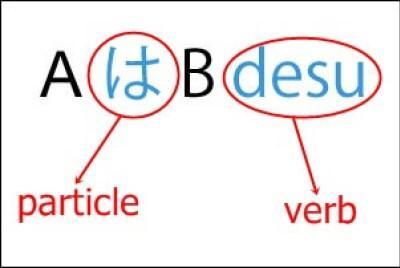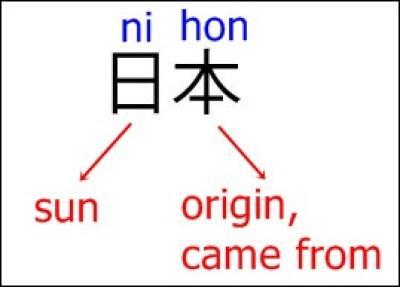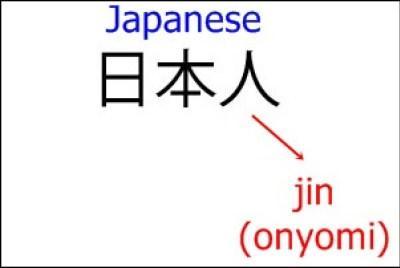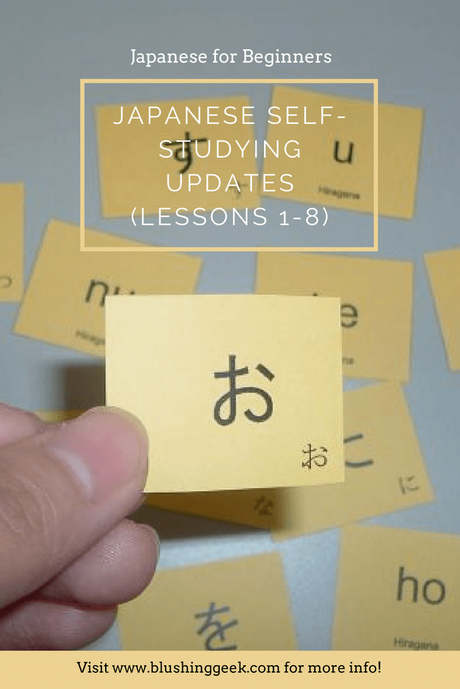Early this year, I had this unrelenting desire to learn how to speak and understand Japanese. But, let’s be honest, language lessons were quite expensive, and besides, I want my experience in learning the language to be an unforgettable and something I would be proud of. Ofcourse learning it on a paid class is still something you’ll be proud of too since you did your best, but I want it to be extra special. Nah, who am I kidding? I’m just broke haha. But seriously, I really wanna know if I could learn the language without enrolling for a paid class *wink.
I’ve been meaning to write this article the moment I started the first lesson but I don’t want to sound like bragging or something, so I set it aside. But now that I’m heading to lesson 9 and how many things I’ve learn so far, I think I really need to share it. I know there are a lot of people who wanna know Japanese but got discouraged because they find it difficult or troublesome, but trust me on this, it’s ALL worth it.
Just like the rest, I’ve been to many websites and Youtube tutorials but to no avail. After 2 or 3 lessons, I got bored then quit. I think the only thing I learn so far from that experience was that I am not carved on studying something alone, I miss the environment of a full class, so I guess that’s the reason why I got boHiragana は isred to all the lessons I’ve been to. So I kind of accepted that the only thing I could learn in Japanese is the characters, Hiragana and Katakana.
After accepting defeat, something unexpected happened. While I was browsing in Youtube, I came across to Misa-sensei’s video about some Japanese rude words to avoid. She explained it so wonderfully, I got curious so I checked out her account and found her Grammar Lessons for Absolutely Beginners playlist. I tried the lesson 1, and my! I LOVED it! So yep, I’m back to learning the language once again.
With all the things going on – blogging, reading, watching anime etc. – I could only accommodate to learn the language atleast once a week. I thought at first it’s not going to be fruitful but I realized that it’s perfect. The last thing I wanna do now is to rush things through, so this schedule is pretty much what I needed. I could watch aleast two lessons and then got a whole week to familiarize and really understand them until I do the next lesson.
Don’t get me wrong, this article is not going to be a tutorial but some sort of summary of what I’ve learn every week. It’s some sort of a journal that hopefully I could visit a year after learning the language (hopefully) and be reminded of what I’ve been through all throughout the journey.
For my first weekly update, it’s going to be pretty long since I’m going to talk from lessons 1-8 so please bear with me *wink.
Note: Click on the lesson number to read the whole lesson.LESSON 1 – Japanese Grammar and Simple Sentence Structure
I already know Hiragana and Katakana so I skipped Misa-sensei’s Hiragana and Katakana guide, I haven’t checked the video but I’m pretty sure it’s as good as her other videos. It’s advisable that you learn them first before you start learning the grammar.

(Translation: Speaking of A, B desu)
- Japanese particles are small words that indicate relations of words within a sentence. For the first lesson, I’ve got to learn the hiragana はwhich is a topic marker. (You can check out more Japanese particles in this link.) For the sentence structure above, A is a topic and desu (which is read as des) is a verb. Example: I’m Vanessa => Watashi wa (は) Vanessa desu (Speaking of Me, it’s Vanessa)
- Hiragana は is pronounce as WA if it is used as topic marker and HA if it is part of a sentence. Example: Spring => Haru (はる)
- Another interesting thing I learn were the meaning behind こんにちは (Hello, Good Day, Good Afternoon => Konnichiha) and こんばんは (Good Evening => Konbanha). As I’ve mentioned, when は is a part of a sentence, it should be read as HA but for こんにちは (konnichiha) and こんにちは (konbanha), they are read as WA. Why is that?
Konnichi – is an old word for today
So こんにちは (konnichiha) simply means as: Speaking of today, or as of today
The は in konnichi is used as a particle and not part of the word.Konban – translate as tonight
So こんばんは (konbanha) originally means as: Speaking of tonight
Just like konnichi, the は in konban is used as a particle and not part of the word.
- Japan has 2 types of readings: Kunyomi (Japanese reading) and Onyomi (Chinese reading) – thus explains the complicated Kanji (adopted Chinese characters).
- Kanji for Japan (Nihon)

hon could also means book, but for this translation, it’s origin or came from
- Japan (nihon) + jin (which means person in Chinese reading – onyomi) = Japanese

Nationality = Country + jin
Examples:
Japanese => Nihon-jin
Filipino => Firipin-jin
American => Amerika-jin
New vocabularies learned from this lesson:
- stupid => baka
- is, it is, a, the, am => desu
- tonight => konban
- konbanwa – good evening => konbanha
- teeth => ha
- today => kyou (what’s commonly used)
- today => konnichi (old word)
- hello, good day, good afternoon => konnichiha
- early, fast, quick => hayai
- light, slow => osoi
- scary => kowai
- cute => kawai-i
- late morning (informal) => osoyou
- good morning => ohayou gozaimasu (formal)
- good morning => ohayou (informal or casual)
- person => hito
- book => hon
LESSON 2 – This / It / That + Adjectives
Note: Konbanha (good night) and Konnichiha (hello, good day, good afternoon) is not usually used to friends as they are very formal and could be rude. Instead, they use aa_.Example: Hi Sakura! => aa Sakura!
Kore – this (you’re holding it)
- Structure: Kore + wa (は)
- Example: (You are holding it) This is a pen => Kore wa (は) pen desu.
Sore – that or it (near you or what the listener is holding)
- Structure: Sore + wa (は)
- Example: (The listener is wearing a ribbon) That is a ribbon => Sore wa (は) ribbon desu.
Are – that (over there – away from both you and the listener)
- Structure: Are + wa (は)
- Example: (Away from both of you) That is a big tree => Are wa (は) ookii ki desu.
VS
Kono – this (you’re holding it)
- Structure: Kono + noun + wa (は)
- Example: (You are holding it) This paper is white => Kono kami wa (は) shiro-i desu.
Sono – is that or is it (near you or what the listener is holding)
- Structure: Sono + noun + wa (は)
- Example: (The listener is wearing a ribbon) That ribbon is cute. => Sono ribbon wa (は) kawaii desu.
Ano – that (over there – away from both you and the listener)
- Structure: Ano + noun + wa (は)
- Example: (Away from both of you) That tree is big => Ano ki wa (は) ookii desu.
Watashi no + wa (は) is different front Kore/Sore/Ano
***
NO is a possessive particle (‘s in English sentence) making watashi which means I to My or Mine.
Example: Emma’s cat => Emma no neku.
New vocabularies learned from this lesson:
- trees => ki
- hair, paper, God => kami
- white => shiroi
- big => ooki-i
- key => kagi
- humongous => dekai (informal)
- water => mizu
- cold (touch) => tsumeta-i
- cold => samu-i (weather)
- next => tsugi
- cat => neku
LESSON 3: Noun Negation
ka is added at the end of the sentence to ask questions. Example: Are you alright? => Daijobu desu ka?Normally, in Japan, when talking with friends, they omit particles (such as wa は), desu (a verb) and ka (used in asking questions). Example: Are you alright? => Daijobu?
Japanese people add the word NE at the end of the sentence all the time. Example: Hot isn’t it? => Atsui desu ne?
NE – means isn’t it? Don’t you think?
They add NE so they wouldn’t stand out or they want them to agree with him/her. (confirmation)
YA suffix is added to stores or shops
Example: Book Store => hon-ya
***
For noun negation, they use either of the following:
- dewa arimasen (formal)
Example: A dolphin is not a fish. => Iruka wa sakana dewa arimasen - ja arimasen (casual)
Example: I’m not American. => America-jin ja arimasen
- ja nai (informal, and which is commonly used for negation)
Example: I’m not well. => Genki ja nai desu
***
Hai (yes) and Iie (no) are not usually used with friends since it’s too formal.
they use un (yeah, yup) and uun (no) instead
New vocabularies learned from this lesson:
- Mt. Fuji => Fuji-san (suffix san comes from Chinese reading -onyomi meaning mountain)
- mountain => yama (Japanese reading)
- yup, yeah, yes => un (informal)
- no => uun (informal)
- but => demo
- dolphin => iruka
- fish => sakana
- well => genki
- alright => daijobu
- pink => pinku
- movie => eiga
- game => geemu
- boring => tsumaranai (tsumannai – most commonly used)
- good looking, handsome, or cool (because it’s manly) => kakko-ii
- new => atarashi-i
- interesting, funny => omoshiro-i
- expensive => taka-i
- church => kyoukai
- delicious, tasty => oishi-i
- hat => boushi
- tasty => umai or umee (mostly used by guys – informal)
- coke => koora
- watch, clock => tokei
- picture, photo => shashin
- drawing => e
- flower, nose => hana
LESSON 4: Adjectives
There are 2 types of adjectives in Japanese
- i – adjective
Examples:
cute => kawai-i
hot => atsu-i
noisy => atsu-i - na – adjective
Examples:
like => suki-na
easy => kantan-na
clean, beautiful => kirei-na
***
i-adjective
- adjectives that ends with i
- Example: This tea is hot. => Kono ocha wa atsu-i desu
na-adjective
- adjectives that ends with na
- na adjectives are good in hide and seek
- when there IS NO NOUN following the na-adjective, EXCLUDE NA
- Examples:
Harry Potter is my favorite book. => Harii potta wa watashi no suki-na hon desu (hon = book [noun] follows suki so we include NA which is now suki-na)
I like dogs. => Inu ga suki desu (there is no noun following suki, so we exclude NA)
New vocabularies learned from this lesson:
- noisy => urusa=i
- easy => kantan-na
- hot => atsu=i
- very => totemo (tottemo – mostly used in casual conversation)
- tea => ocha (mostly refers to green tea)
- winter => fuyu
- dogs => inu
- Canada => kanado
- easy, nice => yasashi-i (formal)
- clean, beautiful => kirei-na
- room => heya
- black tea => koucha
LESSON 5: Negative Adjectives
Negation for i-adjective (i-adjective + kunai) (the last i is excluded)
- kawai-i (cute)=> kawai-kunai (not cute)
- samu-i (cold)=> samu-kunai (not cold)
- atsu-i (hot) => atsu-kunai (not hot)
Examples (i-adjective negation)
- Winter is not hot. => Fuyu wa atsu-kunai desu
- December in Australia is not cold. => Oosutoraria no juu-ni-gatsu wa samu-kunai desu
***
Months in Japanese (number + gatsu)
- Examples: January => Ichi-gatsu, February => Ni-gatsu etc.
- irregular months: April => Shi-gatsu, July => Shichi-gatsu and September => Ku-gatsu
- Know more about Japanese numbers here.
***
Negation for na-adjective (na-adjective + ja nai) (na is excluded)
- kantan-na (easy) => kantan-ja nai (not easy)
- suki-na (like) => suki-ja nai (not like)
- kirei-na (clean, beautiful) => kirei-ja nai (not clean, not beautiful)
Examples (na- adjective negation)
- Public bathrooms are not clean. => Koushuu toire wa kirei-ja nai desu
- I don’t like summer. => Natsu wa suki-ja nai desu
New vocabularies learned from this lesson:
- difficult => muzukushi-i
- sleepy => nemu-i
- quiet => shizuka-na
- serious => shinken-na
- itchy => kayu-i
- arm => ude
- summer => natsu
- a lot of free time (could be referred to as bored because you have nothing to do) => hima-na
- this week => konshuu
- tomorrow => ashita
- the public => koushuu
- public => kou
- bathroom => toire
- public garden => kou-en
- garden => en
- stinky => kusa-i
- house => uchi
LESSON 6: Past Tense & Past Negative
i-adjective Past Tense
- katta – follows the guidelines for kunai (negation in Lesson 5)
- Example: was cute => kawai-i katta
i-adjective Negative Past Tense
- kuna-katta – omit the ending i then add kuna-katta
- Example: was not cold => samu-kuna-katta
Rundown Examples:
cheap => yasu-i
not cheap => yasu-kunai (negation)
was cheap => yasu-katta (past tense)
was not cheap =>yasu-kuna-katta (negative past tense)
***
se ga taka-i = to be tall (about people)
Example: My (older) sister is tall. => Ane wa se ga taka-i desu
***
na-adjective Past Tense
- deshita – formal (follows what are the guidelines for kunai (negation in Lesson 5)
Example: was easy => kantan deshita - datta – informal (follows what are the guidelines for negation in Lesson 5)
Example: was easy => kantan datta
na- adjective Negative Past Tense
- ja nakatta – omit the ending na then add ja nakatta
- Example: didn’t like => suki-ja nakatta
Rundown Examples:
easy => kantan-na
not easy => kantan-ja nai (dewa/ja arimasen) (negation)
was easy => kantan deshita/datta (past tense)
was not easy => kantan ja nakatta (negative past tense)
***
Irregular Adjectives
- ii => good
- kakko-ii => handsome, cool (because it’s manly)
ii Negation
- ii => yo-kunai
- Example: Not smart => Atama ga yo-kunai (lit. the head is not good)
ii Past Tense
- ii => yo-katta
- Example: The movie was good. => Eiga wa yo-katta desu
ii Past Negation
- ii => yo-kuna-katta
- Example: The movie was not good. => Eiga wa yo-kuna-katta desu
Rundown Examples:
good => ii
not good => yo-kunai (negation)
was good => yo-katta (past tense)
was not good => yo-kuna=katta (negative past tense)
***
kakko-ii Negation
- kakko-ii => kakko-yo-kunai
- Example: Mickey Mouse is not cool/handsome. => Mikki mausu wa kakko-yo-kunai desu
kakko-ii Past Tense
- kakko-ii => kakko-yo-katta
- Example: Mickey Mouse was cool/handsome. => Mikki mausu wa kakko-yo-katta desu
kakko-ii Past Negation
- kakko-ii => kakko-yo-kuna-katta
- Example: Mickey Mouse was not cool/handsome. => Mikki mausu wa kakko-yo-kuna-katta desu
Rundown Examples:
cool/handsome => kakko-ii
not cool/not handsome => kakko-yo-kunai (negation)
was cool/handsome => kakko-yo-katta (past tense)
was not cool/was not handsome => kakko-yo-kuna=katta (negative past tense)
New vocabularies learned from this lesson:
- child => kodomo
- when => toki
- cheap => yasu-i
- there is no, doesn’t exist => nai
- money => okane
- warm => atataka-i (they mostly used attaka-i)
- wrist watch => ude-dokei (comes from ude=arm and tokei=watch)
- to be tall => se ga taka-i (used for person)
- sister => ane
- already, not anymore => mou
- now => ima
- exam => shiken
- head => atama
LESSON 7: Verbs
2 types of verbs
- ru verb – iru/eru ending verbs
Examples:
to eat => taberu
to look, to watch, to see => miru
to wake up => okiru
to sleep => neru - u verb – other verbs
Examples:
to write, to draw => kaku
to listen => kiku
to sing => utau
to talk, to speak => hanasu
to say => iu
to buy => kau
to wait => matsu
to exist, there is => aru
to sell => uru
to take, to grab => toru
Irregular verbs
- suru – to do
- kuru – to come
***
wa (は) vs ga (が) particles
は particle (wa) – topic marker
- indicates what the topic is in a sentence
- as for – / speaking of –
- Example: This is a pen. => Kore wa pen desu
- A は B
B is the main thing
(what comes after は is what the speaker wants to tell)
A is just an introduction and just a “topic”
がparticle (ga) – subject marker
- emphasizes what comes before が (ga)
- Example: This is (the one that is) a pen. => Kore ga pen desu
を particle (wo) – object marker
- pronounced as O
- <object> wo <verb>
- Example: (I) (will) eat sushi => sushi wo taberu
***
ni suru – used when ordering in a restaurant
Example: I’ll have pasta => Pasuta ni suru
New vocabularies learned from this lesson:
- to eat => taberu
- to look, to watch, to see => miru
- to wake up => okiru
- to sleep => neru
- to write, to draw => kaku
- to listen => kiku
- to sing => utau
- to talk, to speak => hanasu
- to say => iu
- to buy => kau
- to wait => matsu
- to exist, there is => aru
- to sell => uru
- to take, to grab => toru
- to do => suru
- to come => kuru
- I’ll have, I’ll choose => ni suru
- pasta => pasuta
- multi floor, tall building, Bill (person) => biru
- (general) building => tatemono
- beer => biiru
- medicine, tablet, pill => kusuri
- tablet, pill (formal) => jouzai
- soup => suupu
- milk => gyuu-nyuu (most commonly used)
- milk => miruku (that you order in a cafe)
- tv => terebi
- letter => tegami (comes from te=hands and kami=paper)
- toilet paper => toire no kami
- music => ongaku
- song => song
LESSON 8: Combination of Adjectives and Verbs
no -aside from being used for possessive nouns, it’s also added to adjectives to make it a noun (or ing in English)Example: singing => utau no
<verb> + no + wa/ga + <adjective> Note: Sometimes, especially in a complex sentence, verbs are placed in the middle.
Another Examples:
- Singing is fun. => Utau no wa tanoshi-i desu
- Dancing is not fun. => Odoru no wa tanoshi-kunai desu
- Speaking Japanese is not easy /It’s not easy to speak in Japanese. => Nihongo wo hanasu no wa kantan ja nai desu
- It’s important to have breakfast. => Asagohan wo taberu no wa daiji desu
- I like playing games. => Geemu wo suru no ga suki desu
- they use to do (suru) for play (ing)
New vocabularies learned from this lesson:
- meal, rice => gohan
- morning => asa
- breakfast => asagohan
- noon => hiru
- lunch => hirugohan
- night => ban
- dinner => bangohan
- to teach => oshieru
- study => benkyou (noun)
- to study => benkyou suru
- tennis => tenisu
- mouth => kuchi
- American football => ame futo (informal)
- baseball => yakyuu
- to dance => odoru (informal)
- suffix added for language => go Example: Japanese => Nihon-go
- important => daijina/taisetsuna
- Japanese rice wine => sake
- any alcoholic beverages => osake
- hate, dislike => kirai-na
Once again, this is only a summary of what I learned from each lessons and not a lame attempt for a tutorial. I’ve only included those that I think was important and provided some examples as a guide. If you also want to learn Japanese, I really recommend watching Grammar Lessons for Absolutely Beginners by Misa-sensei. Jaa mata ne!


